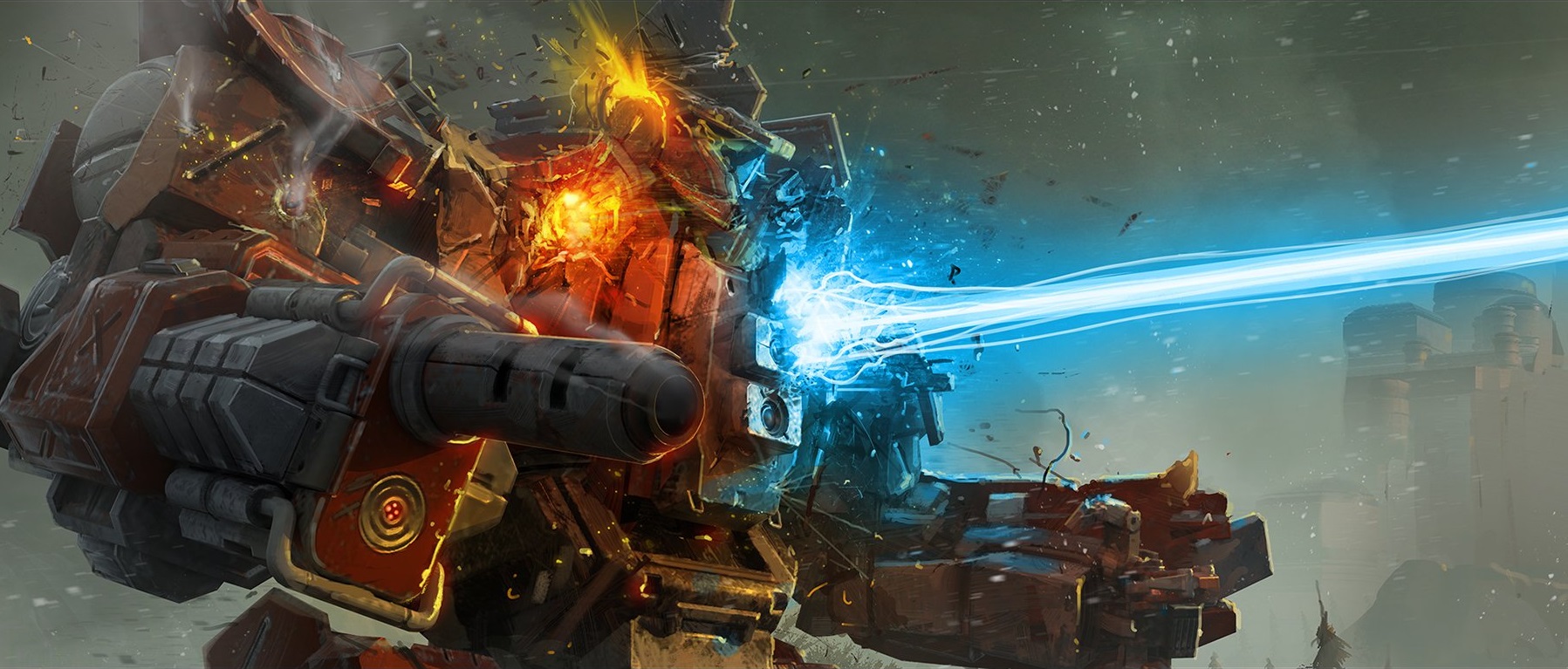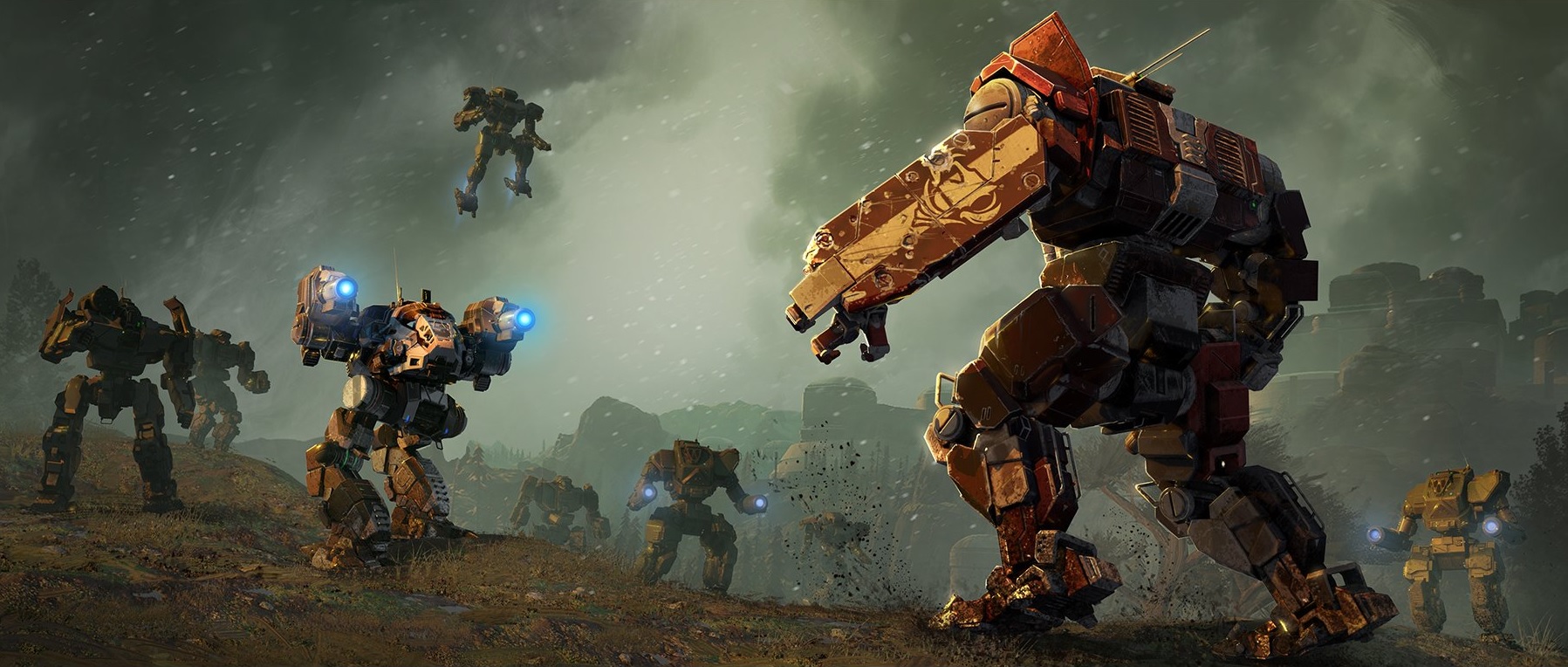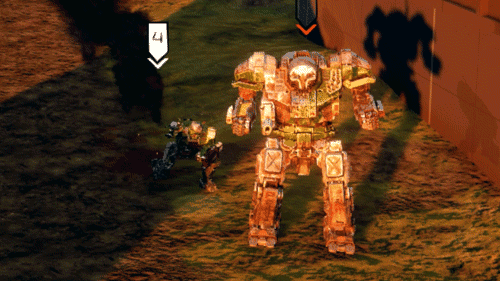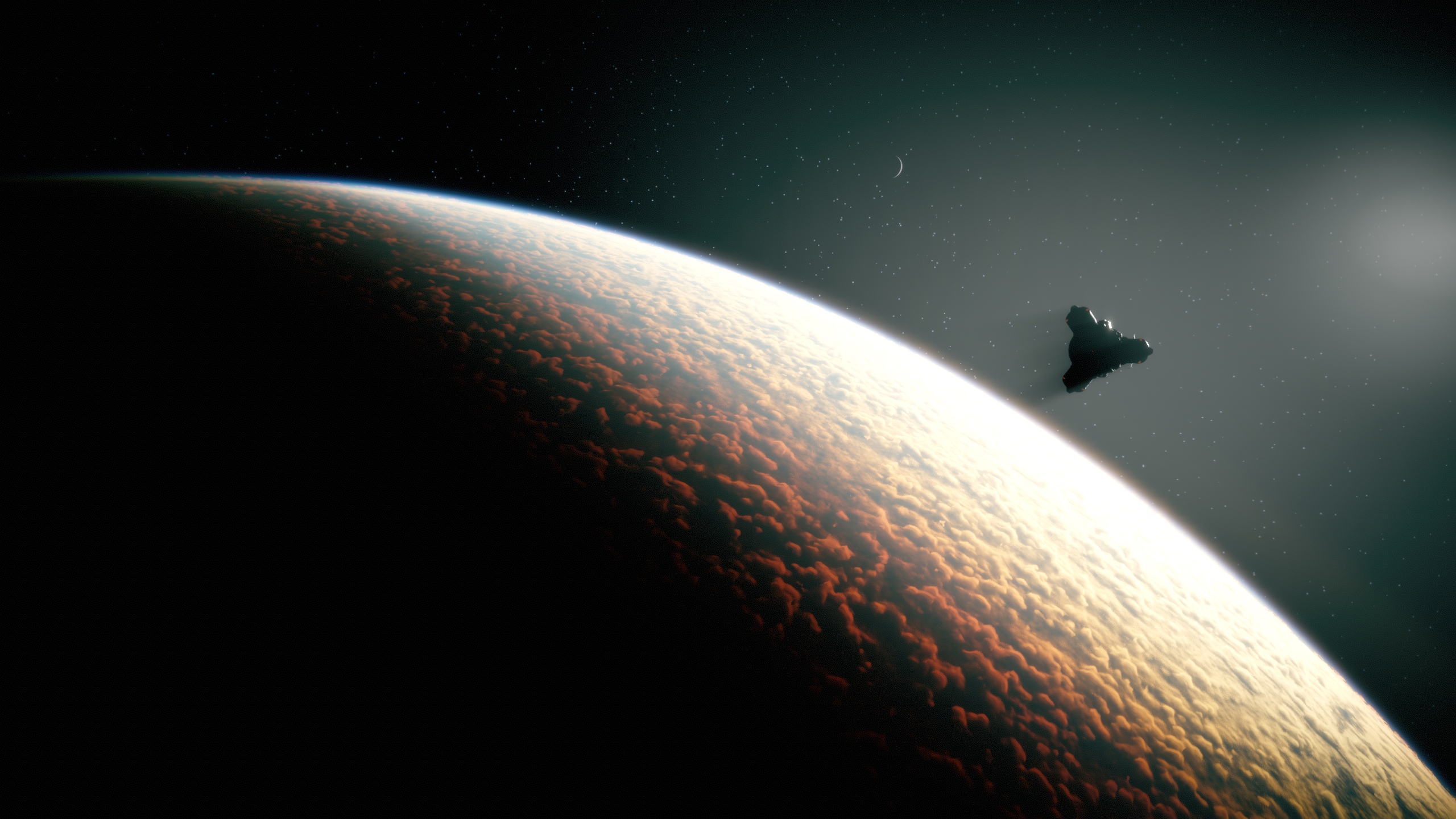BattleTech's complicated lore, explained by its creator
It's 3025. Galactic royals wage war with giant robots, but the secrets of making those robots are mostly forgotten. A quick primer on BattleTech's story and inspirations.

BattleTech's sprawling science fiction story has accumulated over 30 years of games, novels, networked LAN centers, and a 1994 animated series. If you're diving into BattleTech this week but scratching your head at the difference between the Inner Sphere and Star League, or don't know jump jets from JumpShips, here's a primer courtesy of BattleTech's creator, Jordan Weisman.
BATTLETECH BASICS
PC Gamer: Your most recent take on BattleTech is set in 3025. What's humanity managed to achieve in 1007 years?
Jordan Weisman, BattleTech creator and Harebrained Schemes co-founder: Basically, we take to the stars. We develop an interstellar travel capability, what’s called a 'jump.' You can jump from star system to star system. About 30 light years is the maximum jump that can be done. So mankind spreads to the stars. As they do so, communication does not keep up with travel. Communication is stuck in the Pony Express days. We don’t have any kind of interstellar communication except for what travels on JumpShips.
So people can't Snapchat each other across the cosmos. How does that affect the universe?
As people spread out, there’s a kind of safety in blood, blood relations, as opposed to governmental ties. And as we’ve seen several times in human history, when expansion moves faster and to greater distance than quick communications can, you tend to fall back into a feudal sort of organization. That’s what happens as we reach out to the stars. You start getting these vast noble houses, which control star systems and the trade and travel between them. The BattleMech is developed as a solution for how to have a vehicle which can be effective in an enormously wide range of environments, from terrestrial to completely non-terrestrial. It becomes the dominant surface weapon.
Over time, the wars between the various factions are brought to an end by a very compelling leader named Ian Cameron, from one of those noble houses, who manages to get the five other major noble houses, the Great Houses, to agree to band together into a Star League. This becomes the pinnacle of our interstellar society, in that we stop fighting for a while, and put all that energy into building up better technologies, building up a better quality of life.
[BattleTech] is a very conscious retelling of the Roman successor states, with the fall of Julius Caesar, Mark Antony and so on.
So the Star League represents a sort of peaceful golden age?
Keep up to date with the most important stories and the best deals, as picked by the PC Gamer team.
Well, BattleTech is a world of grays. What looks like a great and shining empire from the inside of it looks like a conquering colonial government from the outside. Those who didn’t sign up to become part of the Star League soon find themselves being subjected to or forced to become members of Star League. This starts a series of battles along the edges of known space. That center space has become known as the Inner Sphere, which is roughly centered on Earth, the capital of the Star League. But out on the Periphery, these smaller governments, who had moved out and tried to not be part of the warring states and their politics to begin with, now find themselves faced with this colonial empire. It becomes a long series of battles along the Periphery, the front.
Eventually those Periphery battles start to seed the elements that will eventually tear the Star League apart. After several hundred years. The Star League lasts for several hundred years, and then it falls apart with a combination of insurrection and battles and betrayal. So the Star League—House Cameron is basically wiped out. As part of the insurrection, these operators from the Periphery start to inspire the Houses to become more suspicious of each other, to start to build up their own arms again, as opposed to only trusting the Star League army itself.
This reminds me a lot of Game of Thrones and The Expanse—politics, division between insiders and outsiders. Do these factions have their own militaries?
The Star League army is, to a large extent, based in a feudal system where you would have a knight who would then provide forces to a liege lord, who then owes them to the king. The Star League army is built on that principle. There’s a standing army that’s the Star League’s only, but the majority are House units that are then tributed to the Star League.

THE SUCCESSION WARS
What happens after the dissolution of the Star League?
When the core of the Star League falls with House Cameron, the Star League army, which at the time is led by a guy named Alexander Kerensky—he goes around and they track down and destroy the Periphery forces that assassinated the Camerons. And then watches the Great Houses, rather than staying unified, immediately turn on each other to claim the throne of the Star League. Kerensky doesn’t want to see the enormous amount of firepower under his control used in wars against itself, so he convinces a large portion of his forces to basically exodus from the Inner Sphere. He says, "I give up on these guys. Come on. We’ve all watched them eat at each other for centuries. There was one brief shining moment when they didn’t, and now they’re going to go back to it. If we stick around with our weaponry, we’ll watch humanity destroy itself, and we’ll be the ones doing it. Instead, let’s leave. Let’s go find a new place to live. Let’s strike out and build a better society."
So they go for it. A large percentage of his forces agree, and away they go. Our game takes place 100 years after that event, roughly, where, as he predicted, the five Houses of the Inner Sphere have now gone through three wars of Succession, beating the snot out of each other in a vain attempt to try to reclaim the glory that was the Star League. Our game takes place after the third of those Succession Wars has kind of petered out.
You've talked before about BattleMechs being rare and valuable in this era. What does that mean?
So the result of the warfare over this intervening century has been a rapid decline in the overall technological standing of humanity, from the height of the Star League. We’ve been in this technological retrograde, and we’re still in it in 3025. The BattleMech that was made 100 years ago is better than the BattleMech that’s made today. You get this feudal nature again, passing the suit of armor down from one generation to the next. Now the mechs are passed down in a similar way and maintained, because it represents both your standing and your power.

JumpShips are completely sacrosanct. No one’s ever going to shoot a JumpShip because you can’t make a new one.
This is where BattleTech begins, right? You inherit your family's ancestral Blackjack mech.
That’s exactly right. The analogy I was going to point to… when we started on the game, Mike McCain, the game director, he and I have worked together for many years. He had played MechWarrior 2 when he was a kid. Never really invested himself deeply in the universe. So as we started working on this game he really dove into that. He comes to me after a couple months and says, you know, this story is pretty much identical to Game of Thrones. It was written 10 years before, but it’s pretty much structurally exactly the same.
Having loved the Game of Thrones books, I said, you’re right, it is. In no way do I think he [George R.R. Martin] borrowed it from BattleTech, of course. I think we all stole it from the same place, which is, you know—what this is a very conscious retelling of the Roman successor states, with the fall of Julius Caesar, Mark Antony and so on, tracking down and killing the people who killed Julius Caesar, and then proceeding to eat each other, to a point where, over a course of several hundred years, until the Mongols eventually invade and we end up in the Dark Ages. Not because of the Mongols, but because of the Romans consuming each other. It’s very much that kind of a retelling.
I see. So the Star League was essentially "the height of the Roman Empire."
Exactly right.
So, in review: mankind creates FTL travel, expands outward. Colonization. The formation of the Star League. The disintegration of the Star League and the beginning of the Succession Wars. Kerensky flees with his forces, who will eventually become the Clans. 100 years later you have the start of your game in 3025, which is still in this period of rapid technological decline. BattleMechs are rare—there aren't factories cranking out new Orions and Trebuchets, right?
There are still some BattleMech factories, but they’re fewer and fewer, and they produce lower-quality product than they did 100 years ago. Some technology has taken on an almost mythical quality. We haven’t been able to produce a new jump drive since the fall of the Star League, or within 100 years of the fall of Star League that capability has disappeared. JumpShips are completely sacrosanct. No one’s ever going to shoot a JumpShip because you can’t make a new one.
Similarly, the limited interstellar communication, which is run by an organization called ComStar— technology has taken on this almost mystical quality, where the people who maintain it now have no idea how it actually works. they’ve turned into a monk-like organization that does things by rote with these giant tomes. "Follow process 27 and chant three times and cut open a chicken." Because they really don’t understand the core technology. They’re just trying to maintain it. They also become this kind of independent and sacrosanct group that no one fucks with. All communication flows through them. They’re kind of… they’re my analogy to the Catholic church. As Rome became Christian and then broke into all the different fragments of Europe, the Christian church was the unifying nature. No one taxed it, no one attacked it, and it was central to everything. That’s what ComStar is kind of like.
ComStar isn't exactly a galactic AT&T.
It’s AT&T with all of the… every kind of conspiracy theory you ever imagined, then turned into a quasi-religious order.
One of the hard things for a newcomer to BattleTech to absorb are the various Great Houses. What are the differences between them?
I think one of the key things we were really trying hard to do [in BattleTech 2018] is to make it so you really don’t need to know any of that to come in. One reason we set the game in the Periphery is that we moved it away from the core of those big central Houses fighting each other. Instead, we moved it to a much smaller little entity, where you have a very classic feudal story. A princess was about to take her throne, become queen of the realm, succeed her father, and her uncle usurps the throne. We wanted to keep it kind of small and intimate, because first off, you’re a nobody. The big Houses don’t hire you. When you start off as a mercenary, the Kremlin doesn’t come knocking right away. You’re working for banana republics. That’s this situation. It’s a little tiny group. That’s who is interested. We kind of keep that big many-proper-noun-filled thing a little off stage. That’s hopefully an easier onramp to this stuff.

MERCENARY LIFE
Tell me more about the role of the mercenary in this universe.
Mercenaries fill an interesting niche. One, they’re obviously expendable units, compared to your House or governmental units. But due to the nature of the scarcity of mechs and equipment, they’re more like ronin than a bunch of guys who picked up a sword. Most of these people had to have come—if they have a mech, that mech had to come from someplace.
One of the reasons we set BattleTech in 3025 is because the main forces of the Inner Sphere at the time had just fought this Third Succession War, which ground their industrial and military economies to a point of exhaustion. They’re just not in a position to wage large-scale war at the moment. But their ambitions—while their resources are exhausted, their ambitions are not. They continue to try to make political advantage with everything from small scale skirmishes to crazy-ass plots, and use mercenaries to help them accomplish that. Mercenaries can work anywhere from a small government, like in the case of Kamea and her journey to restore her throne, to local governments who are trying to defend themselves from pirates or bandits. You have wide ranges of potential employers who need some muscle. As you gain in reputation over the course of the campaign, the bigger entities become aware of you and more interested in you. They start hiring you for their political objectives.

THE CLANS
If players give a damn and we get to make more of this, we have a lot of fun ideas.
If I played the MechWarrior games back in the ‘90s, I probably heard about "the Clans." I know they don’t feature in this most recent game, but if I’m a newcomer to BattleTech, how would you explain where they fit in?
They’re about 50 years down the timeline from where we are at the moment. Obviously what wasn’t known 35 years ago when we were rolling out the game in the beginning is that’s who Kerensky and the Star League army becomes. But that’s not known at this point in the timeline. The reason we did that is, we wanted to establish the baseline. We wanted to be able to work our way through the timeline. The Clans bring with them a whole different culture. They bring a whole different technological base. To be able to appreciate that difference, you have to have a baseline to start from, to be able to then understand the differences they bring. It also kind of—from a game mechanic standpoint, we wanted to be able to, again, establish—to not have to take on all the varieties of exotic technology all at once, and create a good solid baseline to which, over time, we can add in all those exotic components. Of course, that depends on people liking the game or not.
What are just a couple of the key figures at this point in 3025 that every person who’s sitting down to play BattleTech should be aware of?
In the context of our story itself, the one that forms the through line of the campaign, Lady Kamea Arano is the one who was supposed to inherit the Aurigan Coalition. She was denied that by her uncle, Santiago Espinosa, who took that realm away. Those are the two political figures that form the core of the immediate drama. The nation states that surround that, that also play into the drama, are the Taurian Concordat and the Magistracy of Canopus, the other two larger Periphery states in the area that figure into the politics. On the larger scale of the Inner Sphere, people like Hanse Davion, who is the head of House Davion, the Federated Suns, his nation sits just above the area that the game is played in. His expansionist tendencies, from the Inner Sphere out here into the Periphery, definitely play a role, as well as Maximilian Liao, who is head of House Liao, the—I only wrote it 30 years ago, you’d think I could remember. The Capellan Confederation. He’s the other compelling leader whose influences are felt in the game.
One of the bigger events in the universe is the marriage of Hanse Davion and Melissa Steiner.
Yeah, that’s not too far down the road, but yeah, that’s a big one. We have, again—if players give a damn and we get to make more of this, we have a lot of fun ideas on how to play with the events leading up to that and what happens after.

Evan's a hardcore FPS enthusiast who joined PC Gamer in 2008. After an era spent publishing reviews, news, and cover features, he now oversees editorial operations for PC Gamer worldwide, including setting policy, training, and editing stories written by the wider team. His most-played FPSes are CS:GO, Team Fortress 2, Team Fortress Classic, Rainbow Six Siege, and Arma 2. His first multiplayer FPS was Quake 2, played on serial LAN in his uncle's basement, the ideal conditions for instilling a lifelong fondness for fragging. Evan also leads production of the PC Gaming Show, the annual E3 showcase event dedicated to PC gaming.

